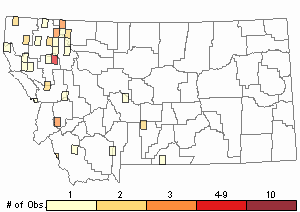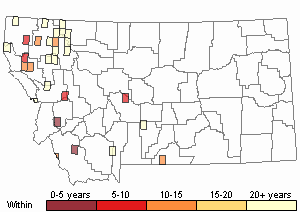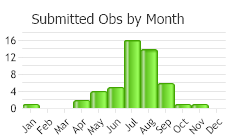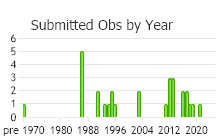View in other NatureServe Network Field Guides
NatureServe
Montana
Utah
Wyoming
Idaho
Wisconsin
British Columbia
South Carolina
Yukon
California
New York
A Rhizomnium Moss - Rhizomnium magnifolium
General Description
Plants: Acrocarpous, growing in open tufts or frequently in cushions, pale green to deep green (Crum and Anderson et al. 1981). Stems russet or reddish, occasionally turning very dark over time, 2-10 cm in height; rhizoids brown (FNA 2014), with macronemata woolly and matted below (Smith 1980), and micronemata present, although not on young growth (FNA 2014).
Leaves: Twisted, curved or bent when dry, spreading to about 45 degrees and typically flat or occasionally slightly wavy when damp, 4-12 mm in length, widest in the middle and quite broad to obovate, ending in a curved or notched leaf tip, or seldom with a short apiculus; margins occasionally somewhat red, flat, smooth; costa not approaching the leaf tip closely to sometimes reaching the apex or nearly so, occasionally forking above, the upper part of the dorsal face smooth (FNA 2014).
Leaf Cells: Margins of 1 or 2 cell-layers (FNA 2014), with a strong border below and of 1 cell-layer above (Crum and Anderson et al. 1981) from about mid-leaf (Smith 1980); marginal cells distinct, long and thin, in 2-4 series; medial laminal cells somewhat long, faintly porose, with slightly thickened wall angles (FNA 2014); distal cells somewhat long and 6-sided, occasionally in diagonal rows (Crum and Anderson et al. 1981); alar cells not distinct from adjacent cells (FNA 2014).
Phenology
Fruit ripens in summer (FNA 2014).
Diagnostic Characteristics
A key characteristic for distinguishing Rhizomnium species is the presence or absence of micronemata on older stems. New growth often lacks micronemata, especially in R. magnifolium, so checking and comparing mature stems, which may be covered with litter, is necessary (FNA 2014).
Small plants of R. magnifolium may be mistaken for Rhizomnium pseudopunctatum. R. pseudopunctatum, however, has marginal cells that are always arranged in 1 layer, shorter, and typically diamond-shaped to rectangular rather than typically arranged in 2 layers, long and thin as in R. magnifolium (FNA 2014).
Range Comments
North American Range
AK, YT, BC and AB s to CA, ID and CO, ON to NL and NS (except PE), MN to MI, PA, NY, ME, NC (FNA 2014). Known in Montana from Flathead, Gallatin, Glacier, Lake, Lincoln, Madison, Mineral, Missoula, Ravalli, Sanders, and Sweet Grass Counties (Elliott and Pipp 2016).
Observations in Montana Natural Heritage Program Database
Number of Observations: 51
(Click on the following maps and charts to see full sized version)
Map Help and Descriptions
Relative Density

Recency



 (Observations spanning multiple months or years are excluded from time charts)
(Observations spanning multiple months or years are excluded from time charts)
Habitat
Damp soil, humus and stone (FNA 2014) in seepy areas, near springs and by watercourses in forests, occasionally partially underwater (Crum and Anderson et al. 1981). Occurring from lowlands to medium altitudes (FNA 2014).
Reproductive Characteristics
Dioicous. Seta solitary, 20-40 mm tall. Capsule 3-4 mm in length; stomata sunken; exostome teeth 16, yellow with green tones; endostome processes present. Calyptra draped like a monk’s hood (FNA 2014).
Stewardship Responsibility
References
- Literature Cited AboveLegend:
 View Online Publication
View Online Publication Crum, H.A. and L.E. Anderson. 1981. Mosses of Eastern North America. 2 volumes. Columbia University Press, New York. 1328 pp.
Crum, H.A. and L.E. Anderson. 1981. Mosses of Eastern North America. 2 volumes. Columbia University Press, New York. 1328 pp. Elliott, J.C. and A.K. Pipp. 2018. A Checklist of Montana Mosses (1880-2018). Updated 3 January, 2020. Montana Natural Heritage Program, Helena, Montana. 73 pp.
Elliott, J.C. and A.K. Pipp. 2018. A Checklist of Montana Mosses (1880-2018). Updated 3 January, 2020. Montana Natural Heritage Program, Helena, Montana. 73 pp. Flora of North America Editorial Committee, eds. 2014. Flora of North America North of Mexico. Volume 28. Bryophytes: Mosses, Part 2. Oxford University Press, Inc., NY. xxi + 702 pp.
Flora of North America Editorial Committee, eds. 2014. Flora of North America North of Mexico. Volume 28. Bryophytes: Mosses, Part 2. Oxford University Press, Inc., NY. xxi + 702 pp. Smith, A.J.E. 1980. The Moss Flora of Britain and Ireland. Cambridge University Press, Cambridge. 705 pp.
Smith, A.J.E. 1980. The Moss Flora of Britain and Ireland. Cambridge University Press, Cambridge. 705 pp.
- Additional ReferencesLegend:
 View Online Publication
View Online Publication
Do you know of a citation we're missing? Elliot, J. C. 1993. Second checklist of Montana mosses. Unpublished report. U.S. Forest Service, Region 1. Missoula, MT. 45 pp.
Elliot, J. C. 1993. Second checklist of Montana mosses. Unpublished report. U.S. Forest Service, Region 1. Missoula, MT. 45 pp. Malcolm, B., N. Malcolm, J. Shevock, and D. Norris. 2009. California Mosses. Nelson, New Zealand: Micro-Optics Press. 430 pp.
Malcolm, B., N. Malcolm, J. Shevock, and D. Norris. 2009. California Mosses. Nelson, New Zealand: Micro-Optics Press. 430 pp.
- Web Search Engines for Articles on "A Rhizomnium Moss"





